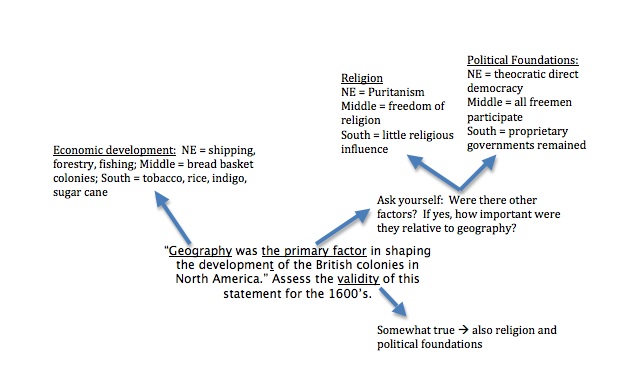Writing the Thesis Statements
What is a thesis statement?
- The thesis statement provides your answer to the question in the
most concise and direct form; it also provides an overview of the
analysis the body of your essay will address and "flesh out"in
more
detail.
How do you begin to write a thesis statement?
I. Identify the key words in the question:
a. What are you being asked to do?
Identify the action verbs:
- analyze: break into smaller components and explain each
- assess: describe and evaluate
- compare: how and in what ways are two or more items
similar,
different
- to
what extent: how much (greatly changed, moderate change, limited
change?), in what way, how long did it occur
- evaluate: determine the value of in terms of
significance, worth
or quality
b. What is the focal topic of the
question? Is there more than one question or topic to be
addressed?
- If there is more than one than one question, it is essential
that you give equal time to each question.
c. Is there a specified time period the
question
addresses? - this is essential! You only get credit for
information within the
given time constraints
of the question; no matter how "correct" the
information is, if it is outside of the time constraints,
it does not
count towards your score.
- The same advice applies to places / regions
and events.
II. Use a concept map to help you identify the categorical /
analysis areas of PERSIA
(see below) that you will use and define them according to the key
words. Note the example question in the center of the
concept map.
- What is the question asking? - How true is the sentence in
quotation
marks? Re-write the question: What influenced the
development of the colonies? Take some notes around the
question. Then, re-evaluate the question as originally
written. Finally, use the concept map to help you write the
thesis:
Example Question: “Geography was the primary factor in shaping
the development of the British colonies in North America.” Assess the validity of this
statement for the 1600’s.
Example Thesis: While geography
shaped the economic
development of the British colonies, the colonies were also
significantly influenced by religious beliefs and moderately influenced
by political foundations of each
colony.
Writing the Essay
Organizing the Essay
Most, though not all, essays are written in the 5-paragraph
format.
I. Introduction
a. provide a general summary of background
information that will set the stage for understanding the answer to
your question - what is
the topic? how did this situation evolve? who are the key players
involved in the situation / what key events led to the situation? At
the end of the paragraph, write your thesis statement.
- Note: your introduction should be no more than 5 sentences;
be concise.
II-IV. Body paragraphs
Each body paragraph should be centered around one of eight concepts; we
will use the acronym PERSIA to help us remember these concepts:
P:
Political: having to do with government. This may include
government structures, offices, laws, political beliefs, political
parties.
E:
Economics: having to do with business and money; how people make
their livelihoods. This may
be the development of private business or government business. It
includes tariffs, taxes, trade.
R: Regional or
Religion:
Regional: having to do with the
differences between varying regions: this may be geographic
differences, cultural differences, etc.
Religion: having to do with differences
in religious belief.
S: Social:
having to do with how people live and how they interact with each
other. In particular, this includes challenges faced by minority
groups (anyone who was NOT white, male, and protestant) in the U.S.
I: Intellectual
or Ideological:
Intellectual: having to do with education or
literary movements; times when large bodies of new knowledge or new
theories were created.
Ideological: having to do with broad based
differences in the belief of how governments and economies should
function. Essentially, this deals with capitalism, communism,
socialism, and anarchism.
A:
Artistic: having to do with development of art and music.
Each paragraph should begin with a corollary statement. This
sentence explains how this concept is connected to, and helps to
answer,
the question. The paragraph should also contain specific examples
that support the corollary sentence. Examples must be specific
- the actions of a specific person, an event, a document, a term,
etc. Always define and describe every specific person / event /
document / term / example you use.
V. Conclusion
a. conclusions should go beyond summary;
if possible, they explain how this topic will influence future events.
Return to main AP US History page

